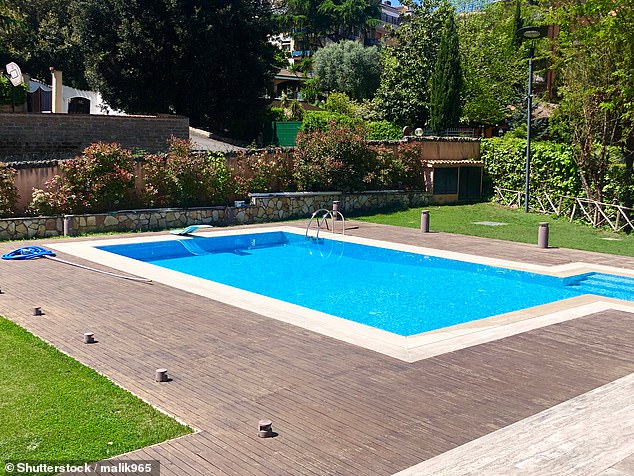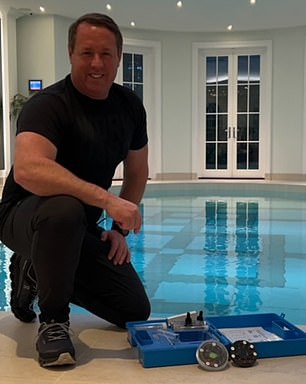We are considering buying a house with a pool. How much would it cost to use?
We are house hunting in our area and found a four bedroom house with a swimming pool in the garden measuring approximately 6 by 4 metres, with a deep end of 1.8 metres.
This £700,000 house ticks a lot of boxes for us, but a pool wasn’t something that needed to be ticked.
We have two young children, so a swimming pool could be a good option, but we are concerned about running costs.
Money pit? A This is Money reader wants to know how much a swimming pool costs to maintain (file image)
Approximately how much would it cost to run year round in terms of heating and regular maintenance such as chlorine and cleaning?
There is currently no lid on it either. How much would it cost approximately to have a high quality automatic cover so that we can use it all year round?
The other option would be to simply fill it. Would that be a wise move, or would the house immediately drop in value?
We’re also not sure what that entails and how much it would cost to do. Any advice is appreciated.
Jane Denton replies: You have shown me the house you want to buy in Essex and it looks fantastic for the price.
However, buying a home with a large pool should not be taken lightly, especially if you have two young children.
If you plan to purchase the property and keep the pool, as you rightly point out, there are several maintenance costs to consider. Swimming pools can be money pits.
To name just a few examples, appropriate pH and chlorine levels must be maintained, the bottom of the pool must be vacuumed and the filtration system must be regularly checked and maintained.
Skimming would become part of your daily vocabulary.
There are also the additional energy and water costs associated with running a pool, which can be significant.
Safety comes first, so it’s wise that you don’t plan to skimp on a decent automatic cover.
Another option would be, as you say, to get the pool filled.
You should carefully assess how much the pool would realistically be used throughout the year and consider whether or not the benefits outweigh the costs and hassle involved.

Fill in time? Filling a swimming pool can be expensive, but it can save costs in the long run
Pete Simpson, from Pete The Poolman in Surrey, says: Buying a home with a swimming pool can be an exciting prospect. They are attractive and, in theory, make a great addition to a home.
But once you’ve moved and lived with a pool for a while, the reality isn’t always so good.
To start with, it is wise to have an expert look at the pool before you buy the house, if the seller agrees.

Swimming pool expert Pete Simpson
For example, they can tell you whether there are leaks, whether the electricity meets the required standards and what the condition and type of heating equipment is on site.
It can be expensive to fix these types of problems.
Finding and repairing leaks can cost thousands of dollars. It’s worth knowing what you’re buying before you take the plunge.
In terms of future costs, owning a swimming pool is like owning a boat: only the water is on the inside.
Heating a swimming pool of the size you are looking at with a modern gas heater for a season without a cover would cost around £100 per week, but with a cover this would be considerably less.
Heating costs vary depending on the outside temperature and the desired pool temperature.
Purchasing a heat pump is another option. These can be pricey and cost thousands of dollars to purchase.
They require the pool to be covered and ideally need an ambient temperature of 12 degrees or more to work effectively and achieve a comfortable swimming temperature.
In addition to heating costs, running the electric pool circulation pump over a summer season would cost around £1,000.
Some pool owners choose to run the circulation pump for a limited time. However, I don’t think this is a good idea. It’s false economics.
Firstly, the heater can only work when the pump is running, causing you to lose valuable heat during pump standstill. Second, the pool would need more help from chemicals to maintain water quality.
The pool that comes with the home you are considering purchasing does not come with a cover.
A good quality ‘walk-on’ hydraulic automatic pool cover could potentially cost you as much as £25,000 for a top model, although cheaper alternatives are also available.
A manual roll or blanket cover costs just £2,000, with the latter retaining heat well but not providing safety for children or pets in my opinion.
Swimming pools should be chlorinated and cleaned regularly.
Depending on the disinfectant you choose, you will need to charge at least €100 per month.
The pool should also be professionally closed for the cold winter months and opened in the same way in the spring.
If you choose to keep the pool, a good weekly routine maintenance and upkeep schedule is the best solution, and perhaps a payment upon entry to the turnstile for all the new friends you make when the mercury rises.
Weekly service charges vary from company to company, but something like £55 to £75 per week, excluding chemicals, would be reasonable.
You may decide that having the pool filled is the best option for your family. Prices vary, but can cost thousands of dollars.
To start, the pool would need to be broken up at the bottom and along the sides.
To allow for the landscaping, the walls must be demolished by more than a meter. A rough guide for the swimming pool at the house you want to buy would be around £20,000 and the possibility of much more if there is no machinery access.
Essentially, a swimming pool is an expensive toy that will keep you entertained for a few days in the summer and a beautiful garden ornament that will impress your guests.


